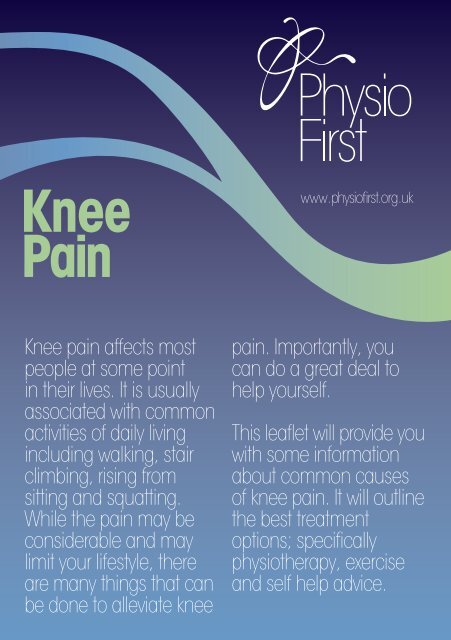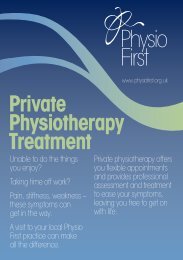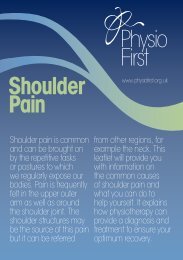Knee Pain Information Leaflet - Blairgowrie Physiotherapy
Knee Pain Information Leaflet - Blairgowrie Physiotherapy
Knee Pain Information Leaflet - Blairgowrie Physiotherapy
You also want an ePaper? Increase the reach of your titles
YUMPU automatically turns print PDFs into web optimized ePapers that Google loves.
<strong>Knee</strong><br />
<strong>Pain</strong><br />
www.physiofirst.org.uk<br />
<strong>Knee</strong> pain affects most<br />
people at some point<br />
in their lives. It is usually<br />
associated with common<br />
activities of daily living<br />
including walking, stair<br />
climbing, rising from<br />
sitting and squatting.<br />
While the pain may be<br />
considerable and may<br />
limit your lifestyle, there<br />
are many things that can<br />
be done to alleviate knee<br />
pain. Importantly, you<br />
can do a great deal to<br />
help yourself.<br />
This leaflet will provide you<br />
with some information<br />
about common causes<br />
of knee pain. It will outline<br />
the best treatment<br />
options; specifically<br />
physiotherapy, exercise<br />
and self help advice.
Physio First works through<br />
helping, teaching and guiding<br />
you, to help yourself to health.<br />
Common causes of knee pain<br />
Common problems<br />
associated with knee pain<br />
The most common cause<br />
of knee pain in younger<br />
adults is patellofemoral pain<br />
syndrome. This condition<br />
is sometimes known as<br />
chondromalacia patella.<br />
In older adults, the most<br />
common cause of knee pain<br />
is arthritis. The most common<br />
type of arthritis affecting the<br />
knee is osteoarthritis.<br />
Injury can also cause<br />
damage to the tissues inside<br />
and around a knee joint;<br />
recent trauma is not covered<br />
in this leaflet.<br />
<strong>Knee</strong> pain can be associated<br />
with a range of symptoms<br />
that may vary from person<br />
to person. The most common<br />
problems encountered are:<br />
Patellofemoral pain syndrome<br />
(<strong>Pain</strong> originating from the back of the knee cap)<br />
— Patellofemoral pain syndrome is the most common cause of pain<br />
in adolescents and young adults<br />
— Many factors, including the shape and size of the knee cap, muscle<br />
strength, flexibility and co-ordination are thought to contribute to<br />
patellofemoral pain syndrome<br />
— Patellofemoral pain syndrome does not always resolve without<br />
treatment, nor does it mean that you will develop osteoarthritis<br />
in later life.<br />
Osteoarthritis<br />
— Osteoarthritis affects approximately 1 in 4 adults<br />
— Osteoarthritis occurs when the bones and the cartilage that make<br />
up the knee joint become damaged<br />
— In most cases, the cause of the damage is unknown. In some cases<br />
it can result from previous injury, being overweight or from family history<br />
— Osteoarthritis is not an unavoidable consequence of aging. Early<br />
detection and diagnosis are crucial in managing the condition<br />
— Just because you have knee osteoarthritis, you will not necessarily<br />
develop problems in other joints.<br />
— <strong>Pain</strong><br />
— Tenderness<br />
— Stiffness of the knee joint, including early morning stiffness<br />
— Swelling of the knee, caused by inflammation<br />
— Muscle weakness, which causes the knee to feel unstable<br />
— Grinding or cracking within the joint<br />
— Loss of mobility<br />
— Difficulty participating in sporting and other physical activities.<br />
It is common for x-rays or magnetic resonance imaging (MRI) to be<br />
performed to help diagnose knee pain.They can be helpful in<br />
diagnosing osteoarthritis.However it is important to remember that<br />
changes on x-ray do not accurately predict symptoms or what<br />
treatment will be best for your knee. For example,many people with<br />
x-ray results showing osteoarthritis will never require knee surgery and<br />
can be helped with simple treatment strategies.
Physio First works through<br />
helping, teaching and guiding<br />
you, to help yourself to health.<br />
Management of knee pain<br />
Exercise and why it is important<br />
Many different types of<br />
treatment are available to<br />
address the symptoms<br />
and underlying causes<br />
associated with your knee<br />
pain. Typical treatment<br />
options may include:<br />
—<strong>Physiotherapy</strong><br />
(individualised or group)<br />
— Podiatry<br />
—Over the counter<br />
medication can help.<br />
If your pain is well<br />
controlled this will allow<br />
you to exercise the joint.<br />
Consult your pharmacist<br />
or GP for advice on<br />
medication.<br />
—Complementary<br />
medicines such as<br />
acupuncture or health<br />
supplements<br />
—Most people do not<br />
require surgery, it may<br />
be considered if the<br />
previous options have<br />
had no success.<br />
How physiotherapy<br />
can help<br />
Physiotherapists are skilled<br />
in the prescription of<br />
exercise. They will provide<br />
you with specific exercises<br />
to improve your strength,<br />
flexibility, balance and<br />
posture as indicated by<br />
a thorough examination.<br />
Therefore, your programme<br />
will be individualised to<br />
ensure the best possible<br />
outcome for your knee.<br />
Physiotherapists also use<br />
other treatment techniques<br />
for knee pain. These may<br />
include:<br />
—Joint mobilising and soft<br />
tissue massage<br />
— Heat or cold treatment<br />
—Electrical stimulation<br />
— <strong>Knee</strong> taping or bracing<br />
—Advice and education<br />
about how best to<br />
manage your condition<br />
—Facilitation of return<br />
to sport and other<br />
functional activities.<br />
Physiotherapists<br />
are experts in<br />
rehabilitation.<br />
Everyone benefits from<br />
regular exercise. Regular<br />
exercise is important in<br />
maintaining overall health<br />
and for preventing chronic<br />
conditions such as diabetes<br />
and obesity. For people<br />
with knee pain, exercise is<br />
particularly important. Even<br />
low-level exercise performed<br />
at home can help to maintain<br />
joint mobility and health. In<br />
fact, research has shown that<br />
regular exercise is one of the<br />
most important treatments<br />
for most knee pain.<br />
Benefits of exercise for<br />
people with knee pain:<br />
— Helps decrease pain in<br />
the knee<br />
— Strengthens weakened<br />
muscles that may<br />
contribute to knee pain<br />
and problems with<br />
physical function in the<br />
first place<br />
— Maintains and<br />
improves joint and<br />
muscle flexibility. This<br />
can prevent or reduce<br />
feelings of stiffness<br />
— Improves posture and<br />
balance<br />
— Reduces depression and<br />
stress levels<br />
— Increases independence<br />
in physical activities<br />
— Improves sporting<br />
performance<br />
— Controls weight and<br />
reduces body fat which<br />
helps to reduce the load<br />
on the knee joint.<br />
There are many types of<br />
exercise that can benefit<br />
people with knee pain<br />
including hydrotherapy,<br />
gym-based programmes,<br />
walking and cycling.<br />
Your Physiotherapist will<br />
help determine the most<br />
appropriate exercise<br />
programme for you.<br />
Everyone<br />
benefits from<br />
regular exercise.
Physio First works through<br />
helping, teaching and guiding<br />
you, to help yourself to health.<br />
Managing your pain<br />
What you ‘kneed’ to remember<br />
about knee pain<br />
Sometimes physiotherapy,<br />
medicines and other<br />
treatments may not relieve<br />
all of your knee pain.<br />
However there are many<br />
things you can do to manage<br />
your pain. These include:<br />
— Take your medications as prescribed by your Doctor or advised by<br />
the Pharmacist<br />
— Do your exercises as prescribed by the Physiotherapist<br />
— Use heat or cold treatments to assist with flare ups of your pain.<br />
Heat may be provided by warm baths or heat packs. Ice packs may<br />
be used to reduce episodes of swelling in addition to pain. Ask your<br />
Physiotherapist which type of treatment is best for your knee<br />
— Ensure your weight is within the health range. Being overweight<br />
places extra stress on the knee joint and contributes to knee pain.<br />
Regular exercise and a healthy diet are important<br />
— Stay positive and try not to focus on your knee pain. Even though<br />
you may have chronic knee pain, it should not stop you from<br />
participating in the things you enjoy. Your Physiotherapist can advise<br />
you how to modify your activities in order to maximise participation<br />
— Relaxation is important in lowering stress levels, reducing muscle<br />
tension and improving your overall sense of well being.<br />
— <strong>Knee</strong> pain affects most people and is rarely caused by<br />
anything serious<br />
— <strong>Pain</strong> is individual and what works for your friend may not work<br />
for you. You may need to try a range of treatments to find the one<br />
that works best for you<br />
— A combination of treatments from your doctor and Physiotherapist<br />
will usually result in the best outcome<br />
— An exercise programme tailored to your specific needs is<br />
important and can be provided by your Physiotherapist<br />
— Accept the advice and reassurance you are given by<br />
health professionals<br />
— Stay active and eat healthily<br />
— Take responsibility for your pain and stay positive.<br />
If you need a little extra help, speak to your Physiotherapist or GP.
Rana S Hinman<br />
BPhysio (Hons), PhD<br />
Kay M Crossley<br />
BAppSci (Physio), PhD<br />
This is a Physio First leaflet:<br />
Physio First represents<br />
Chartered Physiotherapists<br />
working in private practice.<br />
Finding a Chartered<br />
Physiotherapist working nearby.<br />
Chartered Physiotherapists,<br />
like doctors, work to a rigid code<br />
of ethical conduct set by their<br />
professional body and are only<br />
permitted limited advertising.<br />
Chartered Physiotherapists<br />
advertise in Yellow Pages but a<br />
quicker way to find someone close<br />
to your home or work is to look<br />
on the ‘Find a Physio’ section of<br />
www.physiofirst.org.uk or contact<br />
Physio First on 01604 684960.<br />
The information in this leaflet is<br />
intended solely for the purpose<br />
of providing general information;<br />
it is not intended to be, nor is it<br />
to be treated as, a substitute for<br />
professional medical advice.<br />
Always seek the advice of your<br />
Chartered Physiotherapist or GP<br />
for any questions you may have<br />
regarding a medical condition.<br />
Evidence based references are<br />
available on the website<br />
www.physiofirst.org.uk under FAQ.<br />
This leaflet is available in audio<br />
format by phoning 01604 684960.<br />
© Physio First 2008<br />
www.physiofirst.org.uk




